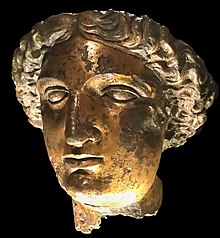
In the localised Celtic polytheism practised in Great Britain, Sulis was a deity worshiped at the thermal spring of Bath. She was worshiped by the Romano-British as Sulis Minerva, whose votive objects and inscribed lead tablets suggest that she was conceived of both as a nourishing, life-giving mother goddess and as an effective agent of curses invoked by her votaries.
Etymology
The exact meaning of the name Sulis has been a matter of debate, but an emerging consensus among linguists regards the name as cognate with Old Irish súil ("eye, sight").
A common Proto-Celtic root *sūli-, related to the various Indo-European words for "sun" (cf. Homeric Greek ἡέλιος, Sanskrit sūryah, from c *suh2lio-) has also been proposed, although the Brittonic terms for "sun" (Old Breton houl, Old Welsh heul) feature a diphthong that is absent from Sulis and they are not attested as a feminine form or with the -i- inflection. Pierre-Yves Lambert argues for a Proto-Celtic form *su-wli-, composed of the prefix su- ("good") attached to the Celtic verbal theme *wel- ("to see").
The medieval Welsh personal name Sulgen (< Sulien; "born from Sulis") and the Breton personal name Sul, borne by a local saint, are also related.
Cult at Bath
See also: Roman Baths (Bath)Sulis was the local goddess of the thermal springs that still feed the spa baths at Bath, which the Romans called Aquae Sulis ("the waters of Sulis"). Sulis was likely venerated as a healing divinity, whose sacred hot springs could cure physical or spiritual suffering and illness. According to scholar Miranda Green, the cult of Sulis at Bath was active until the mid-fourth century CE. Her name primarily appears on inscriptions discovered in an extensive temple area to her at Bath, with only a single instance outside of Britain at Alzey, Germany.

At the Roman temple at Bath, several ancient additions to the altar area suggest that sacrifice there was a major part of worshipping the goddess. The open area surrounding the altar may have been used for processions and public offerings of meats and liquids. A majority of the finds at the spring consist of coins and curse tablets (see "Inscribed tablets" section next), with over 12,500 Roman coins and 18 Celtic coins having been found in the reservoir. In addition, items have also been retrieved that were likely private offerings, such as jewelry, gemstones, plates, bowls, military items, wooden and leather objects.
Pewter vessels found in the spring reservoir have led some scholars to conclude that physical contact with the water may have been important for transfer of healing properties, with these vessels being used to pour the water over visitors' bodies.
From the evidence of funerary inscriptions discovered on the site, it appears that visitors to the sacred springs may have included retired soldiers, soldiers acting as tourists, and/or soldiers looking for relief from injury or illness. In order to afford the inscriptions, those who recorded their visit with altars or tombstones would likely have been of higher status.
The Temple to Sulis Minerva was known for burning coal in the altar-fire instead of wood. This coal would have been brought by slaves, who would also assist in cleaning and service for cult meals.
The gilt bronze cult statue of Sulis Minerva "appears to have been deliberately damaged" sometime in later Antiquity, perhaps by barbarian raiders, Christian zealots, or some other forces.
Inscribed tablets
Main article: Bath curse tabletsAbout 130 curse tablets, mostly addressed to Sulis, have been found in the sacred spring at the Roman baths in Bath. Typically, the text on the tablets offered to Sulis relates to theft; for example, of small amounts of money or clothing from the bath-house. It is evident, from the localized style of Latin ("British Latin") used, that a high proportion of the tablets came from the native population. In formulaic, often legalistic, language, the tablets appeal to the goddess Sulis to punish the known or unknown perpetrators of the crime until reparations are made. Sulis is typically requested to impair the physical and mental well-being of the perpetrator, by the denial of sleep, causing normal bodily functions to cease, or even by death. These afflictions are to cease only when the property is returned to the owner or disposed of as the owner wishes, often by its being dedicated to the goddess. One message found on a tablet in the Temple at Bath (once decoded) reads: "Docimedis has lost two gloves and asks that the thief responsible should lose their minds and eyes in the goddess' temple."
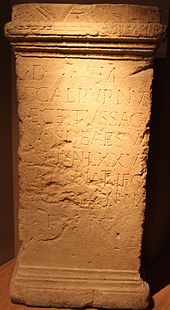
The tablets were often written in code, by means of letters or words being written backwards; word order may be reversed and lines may be written in alternating directions, from left to right and then right to left (boustrophedon). While most texts from Roman Britain are in Latin, two scripts found here, written on pewter sheets, are in an unknown language which may be Brythonic. If so, they would be the only examples of writing in this language ever found.
The only dated tablet of the collection is Bath tablet 94, though no year is given alongside the day and month. This can be inferred, however, by comparison to handwriting used on other tablets, which range from the 'Old Roman cursive' of the second and third centuries CE to the 'New Roman cursive' of the fourth century CE. As argued by Tomlin in his 2020 publication, this shows the popularity of the inscriptions, and therefore the likely belief in their efficacy, for at least two centuries.
Syncretism with Minerva
At Bath, the Roman temple was dedicated to Sulis Minerva as the primary deity of the temple spa. It is likely that devotion to Sulis existed in Bath before the Roman presence in the area, by the local Celtic Dobunni tribe, who may have believed that Sulis had curative powers. Sulis' pre-Roman presence has also been suggested by the discovery of eighteen Celtic Iron Age coins at the lowest levels of the site, as documented by Barry Cunliffe in 1988. This is one of the reasons Sulis is named first in the syncretic Sulis Minerva. Through the Roman Minerva syncresis, later mythographers have inferred that Sulis was also a goddess of wisdom and decisions.
Of the 17 dedicatory altars and bases found at the Roman temple at Bath, 9 evoke Sulis Minerva through her single or double name. In particular, there are two altars found at the Cross Bath (RIB 146) and Hot Bath (RIB 150) sites respectively, which list 'Sulis Minerva' in full. The altar found at the Hot Bath reads "To the goddess Sulis Minerva Sulinus, son of Maturus, willingly and deservedly fulfilled his vow" (RIB 150).
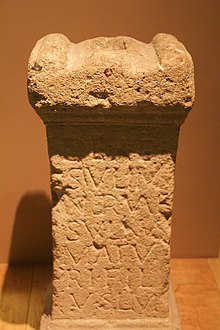
Sulis was not the only goddess exhibiting syncretism with Minerva. Senua's name appears on votive plaques bearing Minerva's image, while Brigantia also shares many traits associated with Minerva. The identification of multiple Celtic gods with the same Roman god is not unusual (both Mars and Mercury were paired with a multiplicity of Celtic names). On the other hand, Celtic goddesses tended to resist syncretism; Sulis Minerva is one of the few attested pairings of a Celtic goddess with her Roman counterpart.
Dedications to "Minerva" are common in both Great Britain and continental Europe, most often without any Celtic epithet or interpretation (cf. Belisama for one exception).
Solar goddess
Based on her name's etymology, as well as several other characteristics, such as the association with sight, civic law, and epithets relating to light, Sulis has been interpreted as a solar deity, at least in pre-Roman times. Some researchers have further suggested a role as the de facto Celtic solar deity, the associated Sulevia and similar names being the goddess's attestations elsewhere.
Modern worship
Sulis has a number of modern-day worshipers among the Wiccan and pagan communities. As of 1998, some people still deposited offerings in the waters of the Roman baths.
Sulis in art and epigraphy
Sulis Minerva's head
A gilt bronze head of the goddess Sulis Minerva was discovered in Bath in 1727 (see top right), which was probably from a cult statue that stood inside her temple, next to the sacred spring. It is possible that this statue was positioned across the temple courtyard from the sacrificial altar site. The statue may be a product of the foundation of the Roman site, dating from the late first-century CE. There are only two other known gilt bronze finds from Roman Britain.
Temple pediment and Gorgon's head
Discovered in 1790, this pediment from the Temple of Sulis Minerva features a large Gorgon's head in its centre. It was likely carved in the first century CE, by craftsmen from northern Gaul. Originally at a height of fifteen metres, the pediment would have been supported by four fluted columns. There are also several accompanying images on the pediment, such as Tritons (the half-fish and half-men servants to Neptune), a face-helmet shaped like a dolphin's head, a small owl, and female Victories standing on globes.

One interpretation of the central image, giving the piece its name, is that the head represents the mythical Gorgon. As Greek mythology has it, the hero Perseus killed the Gorgon and gave the head to Athena, who wore it on her breastplate. Thus, the Roman Baths Museum suggests a possible connection between the Gorgon to the goddess Sulis Minerva (Minerva being the Roman equivalent of the Greek Athena). While the Gorgon on the pediment is male and the mythical Gorgon was female, it has been suggested that the pediment image was altered to reflect a combination of Celtic and classical styles.
Another interpretation is that the central head reflects a water god, due to similarities with other water gods from Britain. For example, the Roman Baths Museum points to a silver dish from Mindenhall depicting the god Oceanus.
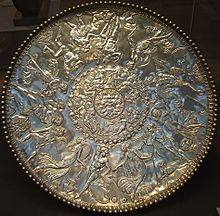
In a 2016 article, Eleri H. Cousins argued that much of the imagery on the pediment can be linked to imperial iconography, including the Victories, the oak wreath and the star at its apex. In addition, Cousins highlighted other examples of similar first- and second-century architectural features, particularly Gorgon imagery found in Gaul and Spain, to suggest that the Forum of Augustus in Rome was used as an overall archetype. According to Cousins, the pediment and its imagery are not just 'Roman' or 'Celtic', but result from a mixture of styles and concepts from "the local to the empire-wide".
Altar-like statue base
The altar-like statue base was found on the pavement nearby the steps of the Temple for Sulis Minerva. The base reads, "To the goddess Sulis, Lucius Marcius Memor, soothsayer, gave (this) as a gift" (RIB III, 3049). This is the only known instance of a haruspex, or professional diviner who interpreted sacrificed animals' entrails, from Britain. The original inscription used the abbreviation 'HAR' to distinguish Memor as a haruspex, but it appears there was a later addition of the letters 'VSP'. This may have been an attempt to clarify his position as more than an informal 'soothsayer', and suggests that Memor may not have been attached to the temple itself, but rather that he may have been a visiting member of the governor's staff.
Altar-like tombstone
This tombstone resembling an altar (see top left) was found with two cinerary urns outside the city of Bath, in the parish of Bathwick, 800 metres north-east of the Roman Baths. The tombstone reads, "To the spirits of the departed; Gaius Calpurnius Receptus, priest of the goddess Sulis, lived 75 years; Calpurnia Trifosa, his freedwoman (and) wife, had this set up" (RIB 155). Receptus' widow's name, Trifosa, is Greek and means 'De Luxe', and would have likely been her given name when she was a slave, before she was freed and married to her former owner, the priest Receptus.
Sulis in modern literature
Sulis has captured the attention of multiple creative writers and storytellers.
Sulis and the Roman Baths have been re-imagined in the following works of historical fiction:
- The Waters of Sul (1989) – Moyra Caldecott
- Flavia's Secret (2008) – Lindsay Townsend
- Crown of Acorns (2010) – Catherine Fisher
- The Curse-Maker (2011) – Kelli Stanley
- Memento Mori: A Crime Novel of the Roman Empire (2018) – Ruth Downie
- The Sinister Booksellers of Bath (2023) – Garth Nix
See also
References
- Joyce Reynolds and Terence Volk, "Review: Gifts, Curses, Cult and Society at Bath", reviewing The Temple of Sulis Minerva at Bath: vol. 2 The Finds from the Sacred Spring, in Britannia 21 (1990: 379–391).
- ^ Delamarre 2003, p. 287.
- ^ Lambert 2008, p. 90.
- Zair, Nicholas (2012). Reflexes of the Proto-Indo-European Laryngeals in Celtic. Brill. p. 120.
- The standard introduction to the archaeology and architectural reconstruction of the sanctuary, with its classic temple raised on a podium at the center, and the monumental baths, with the sacred spring between them, is Barry Cunliffe, ed. Roman Bath (Oxford University Press) 1969.
- Aldhouse-Green, Miranda (2007). "Gallo-British Deities and their Shrines". In Todd, Malcolm (ed.). Companion to Roman Britain. Oxford: John Wiley & Sons. pp. 200, 204–205. ISBN 978-0-470-99885-4. OCLC 437157439. Archived from the original on 29 April 2024. Retrieved 13 April 2021.
- Green, Miranda (1996). "The Celtic Goddess as Healer". In Billington, Sandra; Green, Miranda (eds.). The Concept of the Goddess. London: Routledge. pp. 33–35. ISBN 0-203-45638-6. OCLC 51912602. Archived from the original on 29 April 2024. Retrieved 13 April 2021.
- CIL XIII, 6266, Alzey (Altiaia, Roman Province of Germania Superior): Dea(e) Sul(i) / Attonius / Lucanu
- Maier, Bernhard, 1963- (1997). Dictionary of Celtic religion and culture. Woodbridge, Suffolk: Boydell Press. ISBN 0-85115-698-3. OCLC 36074567. Archived from the original on 29 April 2024. Retrieved 7 January 2021.
{{cite book}}: CS1 maint: multiple names: authors list (link) CS1 maint: numeric names: authors list (link) - ^ Revell, Louise (2007). "Religion and Ritual in the Western Provinces". Greece & Rome. 54 (2): 218–219. doi:10.1017/S0017383507000162. ISSN 0017-3835. JSTOR 20204190. S2CID 161820409.
- Aldhouse-Green, Miranda (2007). "Gallo-British Deities and their Shrines". In Todd, Malcolm (ed.). Companion to Roman Britain. Oxford: John Wiley & Sons. pp. 200, 204–205. ISBN 978-0-470-99885-4. OCLC 437157439. Archived from the original on 29 April 2024. Retrieved 13 April 2021.
- ^ Aldhouse-Green, Miranda (2007). "Gallo-British Deities and their Shrines". In Todd, Malcolm (ed.). Companion to Roman Britain. Oxford: John Wiley & Sons. pp. 200, 204–205. ISBN 978-0-470-99885-4. OCLC 437157439. Archived from the original on 29 April 2024. Retrieved 13 April 2021.
- ^ Henig, Martin (1984). Religion in Roman Britain. London: Batsford. pp. 122–123, 146. ISBN 0-7134-1220-8. OCLC 10837278. Archived from the original on 29 April 2024. Retrieved 13 April 2021.
- "The Official Roman Baths Museum Web Site in the City of Bath". Archived from the original on 15 August 2010. Retrieved 31 March 2009.
- Wilson, Roger (1988). A guide to the Roman remains in Britain. Constable. p. 109. ISBN 0094686807.
- Adams, J. N. (1992). "British Latin: The Text, Interpretation and Language of the Bath Curse Tablets". Britannia. 93. Cambridge University Press: 1–26. doi:10.2307/526102. JSTOR 526102. S2CID 163388305.
- Cf. Fagan, Garrett G. (2002). Bathing in Public in the Roman World. University of Michigan Press. p. 37. ISBN 0472088653., Gager, John G. (1999). Curse tablets and binding spells from the ancient world. Oxford University Press. pp. 194–195. ISBN 0195134826.
- Tomlin, Roger (1988). Tabellae Sulis: Roman inscribed tablets of tin and lead from the sacred spring at Bath. Oxford University Committee for Archaeology. pp. 114–115. ISBN 0947816003.
- CIL VII, 53 = RIB 155.
- Tomlin, Roger (1987). "Was Ancient British Celtic Ever a Written Language?". Bulletin of the Board of Celtic Studies (34). University of Wales: 18–35. ISSN 0142-3363.
- ^ Tomlin, RSO (2020). Britannia Romana : Roman Inscriptions and Roman Britain. Oxford, United Kingdom: OXBOW Books. p. 335. ISBN 978-1-78925-548-5. OCLC 1143479195. Archived from the original on 29 April 2024. Retrieved 21 February 2021.
- Cohen, Paul; Cohen, Brenda (2000). "The Roman Baths Museum In Bath, England". Journal of College Science Teaching. 29 (4): 285–286. ISSN 0047-231X. JSTOR 42990285. Archived from the original on 13 April 2021. Retrieved 13 April 2021.
- Green, Miranda (1996). "The Celtic Goddess as Healer". In Billington, Sandra; Green, Miranda (eds.). The Concept of the Goddess. London: Routledge. pp. 33–35. ISBN 0-203-45638-6. OCLC 51912602. Archived from the original on 29 April 2024. Retrieved 13 April 2021.
- Green, Miranda J. (Miranda Jane), 1947– (2004). The gods of the Celts (New pbk. ed.). Stroud: Sutton. ISBN 0-7509-3479-4. OCLC 56611355. Archived from the original on 29 April 2024. Retrieved 7 January 2021.
{{cite book}}: CS1 maint: multiple names: authors list (link) CS1 maint: numeric names: authors list (link) - ^ Revell, Louise (2007). "Religion and Ritual in the Western Provinces". Greece & Rome. 54 (2): 218–219. doi:10.1017/S0017383507000162. ISSN 0017-3835. JSTOR 20204190. S2CID 161820409.
- "RIB 146. Altar dedicated to Sulis Minerva and the Divinities of the Emperors | Roman Inscriptions of Britain". romaninscriptionsofbritain.org. Archived from the original on 16 January 2021. Retrieved 28 February 2021.
- ^ "RIB 150. Altar dedicated to Sulis Minerva | Roman Inscriptions of Britain". romaninscriptionsofbritain.org. Archived from the original on 13 April 2021. Retrieved 28 February 2021.
- Patricia Monaghan, The Encyclopedia of Celtic Mythology and Folklore, page 433.
- Kotch, John T., Celtic Culture: Aberdeen breviary-celticism, page 1636.
- ^ Marion Bowman (1998). "Belief, Legend and Perceptions of the Sacred in Contemporary Bath". Folklore. 109 (1–2): 28. doi:10.1080/0015587X.1998.9715958.
- ^ "Key objects of the collection". The Roman Baths. 24 October 2014. Archived from the original on 21 April 2021. Retrieved 15 March 2021.
- ^ "Key objects of the collection". The Roman Baths. 24 October 2014. Archived from the original on 21 April 2021. Retrieved 15 March 2021.
- Cousins, Eleri H. (2016). "An Imperial Image: The Bath Gorgon in Context". Britannia. 47: 99–118. doi:10.1017/S0068113X16000131. ISSN 0068-113X. JSTOR 44336599. S2CID 191391802. Archived from the original on 13 April 2021. Retrieved 13 April 2021.
- ^ "Key objects of the collection". The Roman Baths. 24 October 2014. Archived from the original on 21 April 2021. Retrieved 15 March 2021.
- "Key objects of the collection". The Roman Baths. 24 October 2014. Archived from the original on 21 April 2021. Retrieved 15 March 2021.
- ^ Cousins, Eleri H. (2016). "An Imperial Image: The Bath Gorgon in Context". Britannia. 47: 99–118. doi:10.1017/S0068113X16000131. ISSN 0068-113X. JSTOR 44336599. S2CID 191391802. Archived from the original on 13 April 2021. Retrieved 13 April 2021.
- ^ Tomlin, RSO (2020). Britannia Romana: Roman Inscriptions and Roman Rritain. Oxford, United Kingdom: Oxbow Books. pp. 331, 335. ISBN 978-1-78925-548-5. OCLC 1143479195. Archived from the original on 29 April 2024. Retrieved 21 February 2021.
- ^ "RIB 3049. Dedication to Sulis Minerva | Roman Inscriptions of Britain". romaninscriptionsofbritain.org. Archived from the original on 13 April 2021. Retrieved 22 March 2021.
- ^ Tomlin, RSO (2020). Britannia Romana : Roman Inscriptions and Roman Rritain. Oxford: Oxbow Books. pp. 331, 335. ISBN 978-1-78925-548-5. OCLC 1143479195. Archived from the original on 29 April 2024. Retrieved 21 February 2021.
- ^ "RIB 155. Funerary inscription for Gaius Calpurnius Receptus | Roman Inscriptions of Britain". romaninscriptionsofbritain.org. Archived from the original on 2 August 2021. Retrieved 22 March 2021.
- Gibson, Marion (2013). Imagining the Pagan Past / Gods and Goddesses in Literature and History since the Dark Ages. New York: Routledge. pp. 164–165. ISBN 978-1-135-08255-0. OCLC 827955460. Archived from the original on 29 April 2024. Retrieved 13 April 2021.
Bibliography
- Delamarre, Xavier (2003). Dictionnaire de la langue gauloise: Une approche linguistique du vieux-celtique continental (in French). Errance. ISBN 9782877723695.
- Lambert, Pierre-Yves (2008). "Gaulois Solitumaros". Études celtiques. 36 (1): 89–101. doi:10.3406/ecelt.2008.2303.
- Collingwood, Robin George; Myres, J. N. L. (1937). Roman Britain and the English Settlements (2nd ed.). Clarendon Press. p. 264.
External links
![]() Media related to Sulis at Wikimedia Commons
Media related to Sulis at Wikimedia Commons
| Celtic mythology series | ||
|---|---|---|
| Ancient deities of Gaul, Britain and Gallaecia by region | ||
| Supra-regional |
| 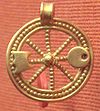  |
| Britannia | ||
| Gallia Aquitania | ||
| Gallia Belgica | ||
| Gallia Celtica | ||
| Gallia Cisalpina | ||
| Gallia Narbonensis | ||
| Germania Inferior | ||
| Gallaecia | ||
- While often rendered as "Sul" in modern times, the correct form of the name is Sulis. See Collingwood and Myres p. 264, and notes at RIB Tab.Sulis 10.